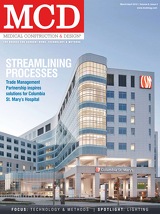Medical Construction & Design (MCD) is the industry's leading source for news and information and reaches all disciplines involved in the healthcare construction and design process. To view more past issues go to: http://mcdmag.epubxpress.com
Page 32 of 70
5
6
5. The design team took particular care to locate outdoor air intakes away from sources of contaminated air, such as that produced from helicopter exhaust. 6. Air-handling units are equipped with the capability to use outside air directly for "free cooling," reducing the use of electricity of the central cooling plant equipment.
High-tech touches
Community contaminant prevention of airborne releases was particularly important to the hospital, which did not want air discharged from the two isolation rooms to carry contagions. The air from these negative-pressure rooms is 100-percent exhausted; no air is re-circulated. The exhaust runs through HEPA fi lters, which are 99.97-percent effective at removing contagions.
The planning ultimately led to a mechanical system design that consists of a new central energy plant with high-effi ciency water-cooled chillers and redundant heating water boilers for continued heating capability even if a par- tial equipment failure should occur. Air-handling units are also equipped with the capability to use outdoor air directly for cooling ("free cooling"), reducing electricity use by the central cooling plant equipment. Particular care was taken to locate outdoor air intakes away from sources of contami- nated air, such as the rooftop helipad.
All of the mechanical equipment is monitored and con- trolled by an electronic energy management and control system, which provides continuous monitoring of equip- ment operation, allowing building engineers to optimize building systems and maintain patient and staff comfort, while minimizing energy use. Access of the system through the Internet allows building engineers to monitor and adjust operation from remote locations.
Electrical service is provided at 480Y/277V by a pad- mounted transformer near the central plant. The essential electrical supply system comprises a 750 kW diesel engine generator set located in a sound-attenuated room adjacent
28 Medical Construction & Design | March/April 2012
to the main electrical room. Power is distributed via four automatic transfer switches to life-safety and critical equip- ment to ensure service disruption is avoided. An emer- gency generator maintains essential healthcare operations during utility power failure.
Communication between staff and patients is facilitated by a nurse call system incorporating two-way voice com- munication, electronic tones and illumination of indicating lamps in the patient-care and staff areas. Design of the hospital's lighting systems creates a calm and soothing atmosphere for both patients and their families through the use of decorative sconces and pendants. At the same time, in areas where code dictates specifi c lighting requirements, specialty healthcare fi xtures were specifi ed, providing suffi cient light levels necessary to perform hospital tasks. By making energy effi ciency a priority in its new facility, Providence Mount Carmel Hospital not only enhanced the quality of healthcare provided to the community for years to come, it also demonstrated its commitment to being a good steward of natural, as well as fi nancial resources.
Providence Mount Carmel Project Team Architect: KDF Architecture General Contractor: Bouten Construction Structural Engineer: Coffman Engineers MEP: MW Consulting Engineers Interior Design: KDF Architecture Landscape Architect: Environment West Landscape Services
www.mcdmag.com
